A sampling of results and impacts from recently completed New York Sea Grant's extension and education initiatives.
<< back to NYSG Success Stories introduction page
2012 Projects Impact New York’s Coastal Resources
Ithaca, NY, April 1, 2013 - New York Sea Grant has issued a series of
impact statements for projects completed in 2012. The success of these outreach projects—made possible by collaborating
with national, state, regional, and local partners—shows how Sea Grant’s
depth of programming can benefit NY’s shoreline regions and have a
profound impact on its coastal communities and economies. They include:
- NYSG quickly provided coastal managers with sound information about Hurricane Sandy when needed most
- NYSG planned and co-facilitated a series of six Lake Ontario visioning workshops in 2012
- Helping NY seafood gain recognition in local food systems helps New York’s fishing businesses, increases visibility, productivity and profitability of NY’s high quality seafood products
- NYSG continues to be a national leader in seafood safety training
- NYSG funded researchers in the area of harmful algal blooms (HABs) conducted research, most of it on the genetic/molecular level and published their findings
- NYSG helped make a new real-time, web-based tool available to recreational boaters on the St. Lawrence River
- NYSG and partners have developed innovative educational programs serving thousands of teachers and students in the downstate areas
- The cooperative Undo the Great Lakes Chemical Brew campaign educates the public about what they can do to keep the chemicals in pharmaceuticals and personal care products (PPCPs) out of the Great Lakes
- NYSG co-organized a Lake Ontario “Scenarios” Workshop to manage future uncertainty
- NYSG continues to support world-class researchers in these areas of fish pathology
- NYSG promotes inter-municipal initiatives to reduce pollutants transported to the coast by runoff
- NYSG’s successful Launch Stewards Program educates boaters in efforts to protect NY waters from aquatic invasive species
- NYSG helped identify four high-risk aquatic invasive threats to the Great Lakes
Below, you will find NYSG's individual Extension Impact Statements for 2012. You can also download these impacts atatements as an entire collection or in a two-page summary:
- 2012 Project Summaries Show Impact on Coastal Waters, Communities, Youth, Economy & Educators (pdf) [15 pp.]
- New York Sea Grant Impacts (pdf) [2 pp.]
Coastal Hazards
-
New York Sea Grant NEMO: Promoting Regional Water Quality Protection Initiatives (pdf)
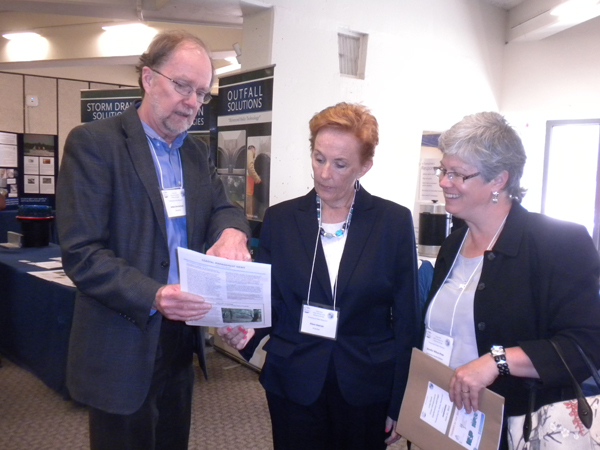
As development and population pressures have grown on Long Island, impacts to water quality, fisheries, and beaches have become costly. So, for well over a decade New York Sea Grant's Nonpoint Education for Municipal Officials Program (NYSG NEMO) has been building relationships with municipalities including Glen Cove, Huntington, Manhasset, Oyster Bay and Cold Spring Harbor to promote initiatives that help reduce the pollutants transported to the coast by runoff.
Just this past week, NYSG was a sponsor of the 2nd Annual Long Island Green Infrastructure Conference and Expo, held at Brookhaven National Laboratory. The event's focus was ‘How to Address Water and Energy Issues and Benefit by Going Green During Tough Economic Times.’ Pictured here at last year's conference, Dr. James Ammerman, then NYSG Director, Eileen Keenan, NYSG water quality specialist and Manager of the NYSG NEMO Program discuss water quality issues with Jennifer Wilson-Pines, Executive Director of the Manhasset Bay Protection Committee. Photo (above) by Barbara A. Branca
For more on this year's event, check out NYSG's related news item.
-
Quick Response by New York Sea Grant Provides Information to Better Manage Hurricane Sandy Impacts (pdf)
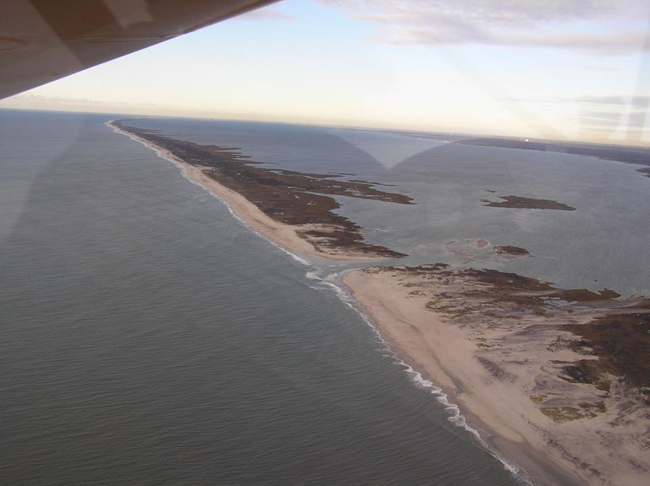
Hurricane Sandy created the breach pictured here in the Fire Island National Seashore near a residential area valued at $10 billion. Photo (above): Charles Flagg
By acting as a bridge between decision-makers and researchers, New York Sea Grant was able to quickly provide sound information to coastal managers, including the National Park Service, when they needed it most. NPS used NYSG information to evaluate the condition of the breach and its impacts, and decided not to close it immediately, which would have cost approximately $6 million.
For more on the topic, see the related "New York Sea Grant Responds to Superstorm Sandy" story, as well as NYSG's Hurricane Education archives, www.nyseagrant.org/hurricane.
Healthy Coastal Ecosystems
- Undo the Chemical Brew: Keeping Unwanted Medicines Out of NY’s Waters (pdf)
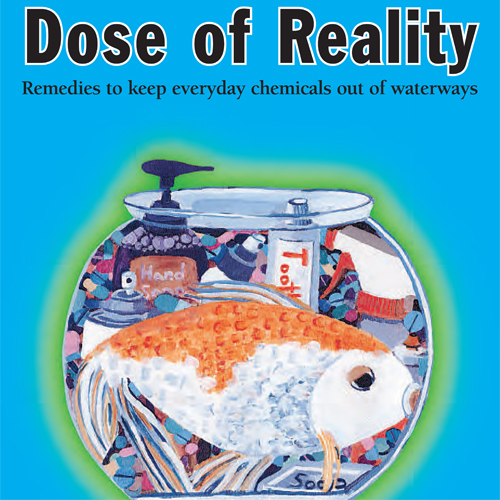
New York Sea Grant, Pennsylvania Sea Grant, Illinois-Indiana Sea Grant, and Ohio Sea Grant have partnered to create a highly successful Undo the Great Lakes Chemical Brew project, funded by the Great Lakes Restoration Initiative.
Since its inception in 2010, the Undo the Brew team has collected 2.7 million pills for proper disposal, and informed more than one million anglers, educators, students, 4-H youth, medical professionals, legislators, and community members about the need to keep the chemicals in pharmaceuticals and personal care products (PPCPs) out of the Great Lakes.
A NYSG-produced fact sheet as well as promotional pieces encouraging interested citizens to learn simple ways they can be wise coastal stewards can be found at www.nyseagrant.org/unwantedmeds.
- New York Educators Help Restore Gulf Coast Habitats (pdf)
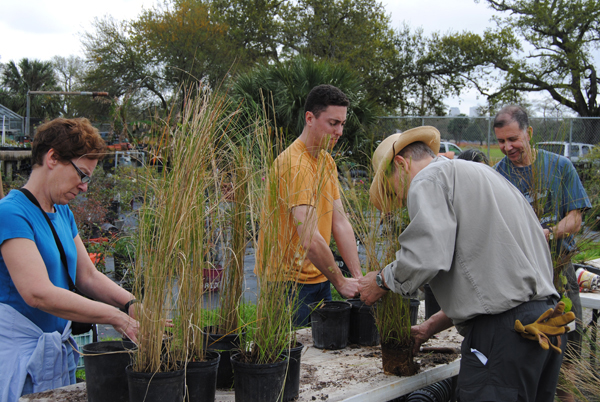
As featured in Louisiana's WaterMarks magazine, National Oceanic and Atmospheric Administration (NOAA) Coastal Services magazine and reported by several media outlets: To learn about wetland loss in southern Louisiana and how it relates to the habitat loss occurring in New York, a group of 14 educators traveled to the Bayou State in late February 2012 to rebuild habitats devastated by recent natural and man-made events. This was the second time in as many years that such a trip was planned.
As pictured here, attendees worked one of the days with Louisiana Sea Grant at the Wetland Plant Center in New Orleans to pot native wetland vegetation which will be planted at various wetlands around southern Louisiana. Photo courtesy of Larissa Graham.
New York Sea Grant (NYSG) and the New York State Marine Education Association (NYSMEA) led these trips to the Gulf Coast to help educators understand the need for stewardship of New York’s wetlands. For example, in New York’s Jamaica Bay, a 39-square-mile estuary that includes portions of Brooklyn, Queens, and Long Island’s Nassau County, wetlands are being lost at a rate of 44 acres per year.
Also, check out NYSG's related news item, "New York Volunteers Augment Restoration’s Success in Southern Louisiana."
NYSG's Web Content Manager Paul C. Focazio also produced numerous posts in 2011 and 2012 during both trips to NYSMEA's "Louisiana learning blog series at ww.nysmea.blogspot.com.
- NYSG Helps Students Assist Local Restoration Project (pdf)
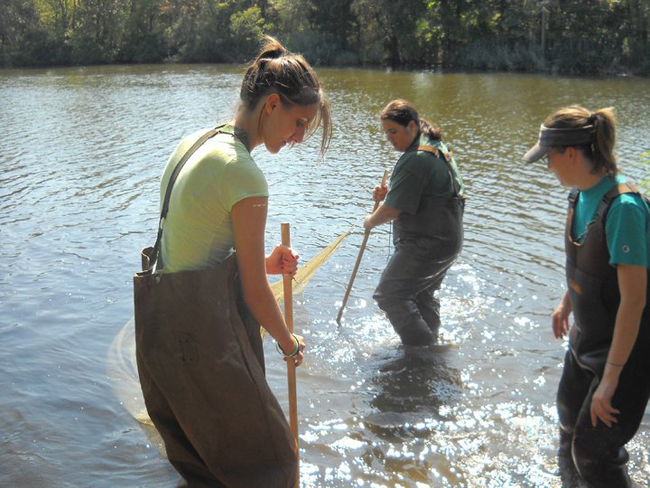
New York Sea Grant values its partnerships with watershed interest groups to provide local students with hands-on learning opportunities. For example, NYSG has been working with the NYS Office of Parks, Recreation, and Historic Preservation and the New York State Department of Environmental Conservation on a Sound #Stewards program, from which students collect data as part of their research projects.
Starting in 2008, students from Hauppauge High School on Long Island, NY, traveled to Sunken Meadow State Park twice a month to collect data on water quality, fish populations and more in Sunken Meadow Creek. Heather Young, Long Island Sound Study's habitat restoration coordinator, is pictured here helping students use a seine net to sample fish at Sunken Meadow State Park. Photo (above) courtesy of Larissa Graham.
Last fall, the floodwaters of Hurricane Sandy washed away much of the creek's culvert system, which, built in the 1950s, was restricting tidal flow in its lower reaches and restricting the natural flow and flushing of the waterway. Hurricane Sandy's action resulted in a 50-foot break in the berm built on Sunken Meadow Creek that restored tidal flow to the Creek - one of the objectives of New York’s Nissequogue River Watershed Action Plan.
For more on what you can do to make a difference, click over to the "Get Involved" or "Stewardship" sections of the Long Island Sound Study's Web site. NYSG also has a related news archives at www.nyseagrant.org/lisound.
- Outreach Coordinator Increases Stewardship for Long Island Sound (pdf)
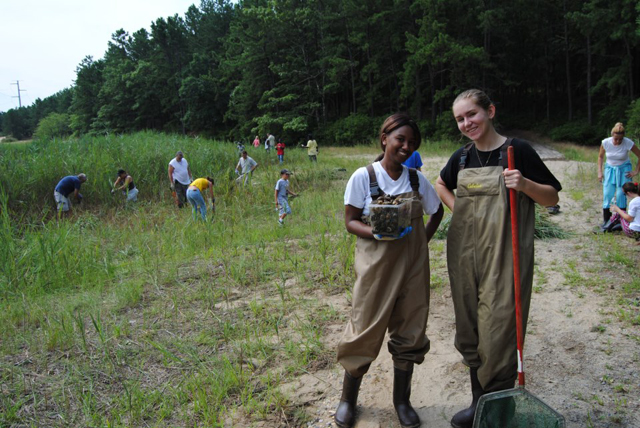
Last Summer and Fall, NYS Office of Parks, Recreation, and Historic Preservation (NYS OPRHP) and the Long Island Sound Study (LISS) held four volunteer events around the Long Island Sound at recreational and ecological important LISS-designated Stewardship Areas.
These events were part of New York Sea Grant’s Long Island Sound Stewardship Initiative, which was created to protect the areas around the Sound that are not only important for plants and animals, but also for residents that use these areas for recreational purposes.
Late last summer, volunteers (like the ones pictured above) came out to Brookhaven State Park to remove Phragmites and collect invasive Chinese mystery snails. They were all wise to wear their long pants and rubber boots, and come equipped with work gloves, sunscreen and bug spray. Photo courtesy of Long Island Sound Study.
In 2008, the Sound Stewards program was developed to involve middle and high school students in research projects in LISS Stewardship Areas. New York Sea Grant worked closely with partners, including the New York State Department of Environmental Conservation, NYSOPRHP, Stony Brook University, and LISS, to develop research projects that allow students to learn about the problems facing Long Island Sound, while collecting data that will be used by partner agencies. To date, more than 1,900 students have been involved in these research projects.
Learn what you can do to make a difference - click over to the "Get Involved" or "Stewardship" sections of the LISS's Web site. NYSG also has a related news archives at www.nyseagrant.org/lisound.
- Long Island Sound Mentor Teacher Program (pdf)

In 2012, New York Sea Grant continued a successful Long Island Sound educational initiative for K-12 teachers in the New York’s share of the watershed that includes the Bronx, Queens, and Westchester County.
This Long Island Sound Study program built upon efforts made in 2011, when the program featured trainings at Cedar Beach in Mount Sinai, NY and Caleb Smith State Park in Smithtown, NY. During the workshop in Mount Sinai, participants (pictured here, above) tested water quality, seined, and learned many Sound health facts. For more on these sessions, see NYSG's related news item. Photo courtesy of Larissa Graham.
To date, this mentor teacher initiative has conducted 33 workshops in Connecticut and New York with more than 300 formal and informal K-12 educators and has reached through those educators, more than 20,000 students. Funding was secured to continue this program with two workshops in 2014.
Learn what you can do to make a difference - click over to the "Get Involved" or "Stewardship" sections of the Long Island Sound Study's Web site. NYSG also has a related news archives at www.nyseagrant.org/lisound.
- NYSG Develops Coastal Sea Change Education Materials for New York’s Hudson/NYC Estuary Region (pdf)
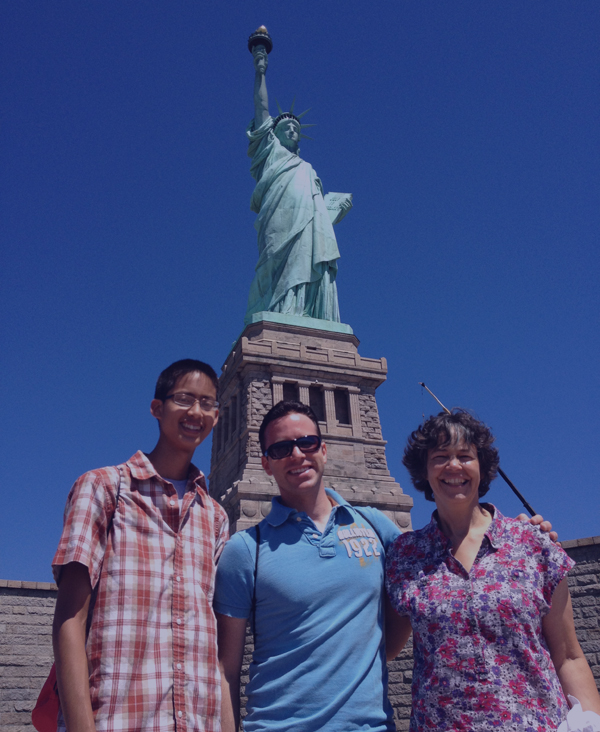
In the wake of Sandy late last October, Liberty Island (home to the Statue of Liberty, pictured here; Photo: Paul C. Focazio, NYSG) and Ellis Island were both closed indefinitely while the National Park Service (NPS) assessed post-storm damage. Although the statue itself was not damaged by the storm, Liberty Island suffered significant damage to its infrastructure. Bricks were ripped up from pavements and Liberty Island’s dock, where tourists arrive by ferry may need to be rebuilt completely.
After months of repair to the island's damaged docks, energy infrastructure and security system, the NPS will reopen the Statue of Liberty on July 4, 2013. NPS provides updates on the status of access to Liberty Island via a section on their Web site, www.nps.gov/stli.
Last summer, New York Sea Grant (NYSG) Hudson Estuary Specialist Nordica Holochuck (pictured at far right) hosted Bryan Chan (pictured at far left), a Cornell University's College of Agriculture and Life Sciences at Cornell University (CALS)-sponsored undergraduate intern in her Kingston office. Chan worked with NYSG Web Content Manager Paul C. Focazio (pictured in middle) to develop educational curricula for a number of sites, including Liberty Island, as part of a Web-based mapping project on coastal change over time along more than 500 miles of New York's urban coastal and estuarine environments. This content will be online in the coming months.
For more on this story, including video blogs of Chan's weekly progress, see NYSG's related news item, "Sea Grant Helps Cornell Document Change, Develop Educational Curricula for NYC Sites." Also, see NYSG's related impact statement for more on this project (pdf).
- NYSG-Buffalo State College Collaboration Identifies Four High-Risk AIS Threats to Great Lakes (pdf)
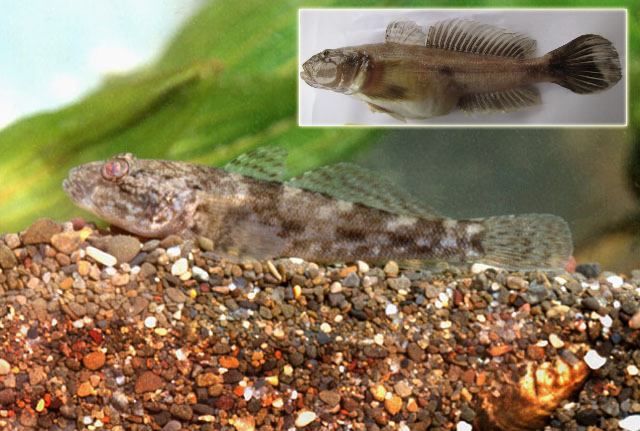
New York Sea Grant's collaborations with academic partner Buffalo State College is helping identify aquatic invasive threats to the Great Lakes.
More than 180 aquatic invasive species (AIS) have been introduced into the Great Lakes, causing a variety of negative ecological and economic impacts. Ballast water discharge has been implicated as a major vector of these introductions, largely originating from the Ponto Caspian region of Eurasia.
Through a collaborative effort between New York Sea Grant and Buffalo State College, current and emerging aquatic invasive threats to the Great Lakes are being identified. This year, NYSG is developing fact sheets on four fish in particular that are deemed at high risk for introduction into North American waters. These fish are: kilka, Volga dwarf goby, black-striped pipefish and, (pictured here, above, Caspian bighead goby. Photos: Nina Bogutskaya and, insert, Brian Coad.
For more on Aquatic Invasive Species and Great Lakes Fisheries see, respectively, www.nyseagrant.org/ais and www.nyseagrant.org/glsportfish.
- NYSG Facilitates Lake Ontario Scenarios Look at the Future of Great Lakes Ecosystems (pdf)
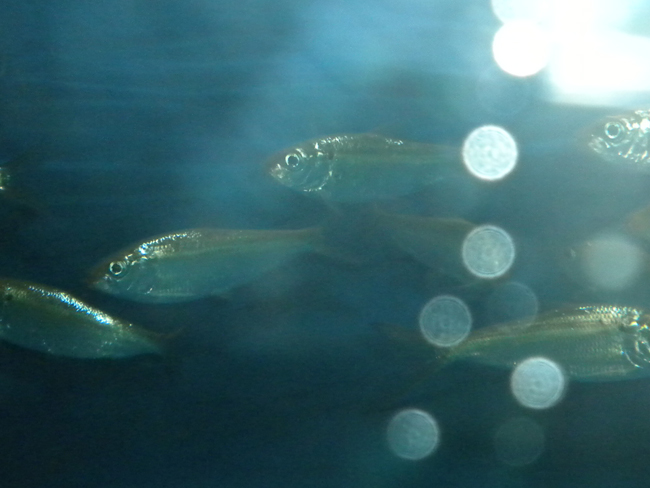
Escalating changes in Great Lakes ecosystems have many concerned about the sustainable management of our region's coastal resources. That is why last fall New York Sea Grant (NYSG) and the U.S. Geological Survey (USGS) organized a Lake Ontario Scenarios Workshop to help 30 diverse stakeholders representing research, management, businesses, and #conservation organizations manage future uncertainty.
"Scenarios are gaining acceptance among ecologists as tools for proactive strategic planning," says NYSG Great Lakes #Fisheries Specialist Dave MacNeill. "Decision-makers use scenarios to critically evaluate the uncertain future dynamics that could result in sudden events, catastrophic or otherwise, and how these events could unfold."
Pictured above: NYSG-funded researchers led by Buffalo State College biologist Dr. Randy Snyder have studied alewives to, among other things, help improve fisheries managers’ ability to optimize salmonid stocking rates. This two year project, which wrapped up around 2010, was designed to improve understanding and accurate forecasting of the condition and growth of alewives, an important component of the Great Lakes food web.
“They are a great forage fish for Lake Ontario’s salmon population,” Snyder says, “but unfortunately, that’s based on both an invasive (alewife) and an introduced, stocked species (Pacific salmon).” Photo: Paul C Focazio
Additional information about NYSG's Great Lakes Fisheries efforts can be found via its related resource site, www.nyseagrant.org/glsportfish.
- NYSG Launch Stewards Engaging Public in Watercraft Inspection to Slow Spread of AIS (pdf)
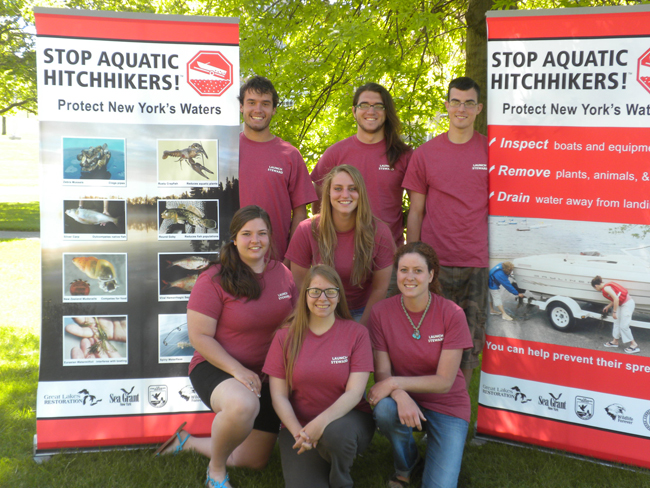
The New York Sea Grant Launch Stewards Program educates and empowers boaters in the effort to protect New York waters from aquatic invasive species. In 2012, the NYSG Launch Stewards: monitored 12 launch sites; educated 5,701 people; and conducted 2,456 watercraft inspections - 72% of which were NYS-registered boats. 10% of the #boats had visible debris, such as Eurasian milfoil, water chestnut, curly leafpond weed, algae.
The seven college students hired to be this year's 2013 NYSG Launch Stewards (pictured above; photo: Mary Penney, NYSG) have been trained and are now covering the eastern Lake Ontario shoreline from Sodus Bay to Henderson, the Oswego River, Little Salmon River, Salmon River, Sandy Creek, Stony Creek, and the Oneida Lake South Shore from Bridgeport to Brewerton. You can keep tabs on their activities this summer via posts on their blog, http://nysglaunchsteward.blogspot.com/.
NYSG Launch Stewards Program Partners: FingerLakes-Lake Ontario Watershed Protection Alliance, New York State Department of Environmental Conservation and the U.S. Fish and Wildlife Service Great Lakes Protection Funds Program.
For more, also see NYSG's related news item, "NY Sea Grant Waterfront Launch Steward Program Expanding for 2013," as well as the resources provided via NYSG's related "Coastal Community Development" Web site, www.nyseagrant.org/ccd.
Safe and Sustainable Seafood
- NY Sea Grant Brings Recognition of Seafood into Local Food Systems (pdf)
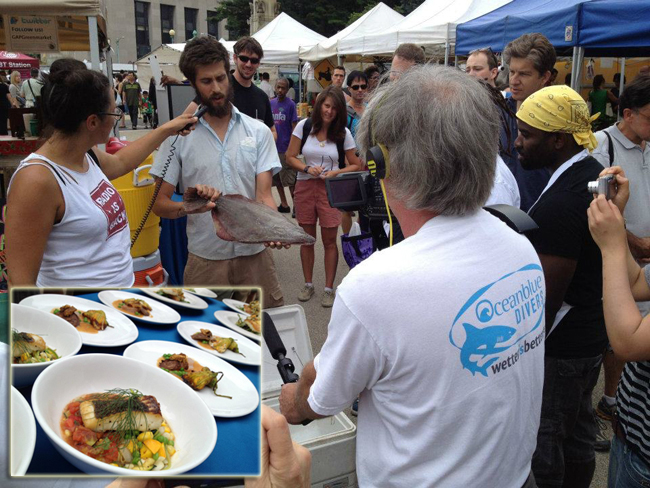
In 2012, New York Sea Grant (NYSG) helped New York’s fishing communities integrate seafood products into local food systems. These activities connected with more than 2,000 New York City / Long Island area residents and four new community supported fisheries (CSF) businesses were launched over two years in New York through the local food systems movement.
As pictured here, fresh local fish was transformed into a chef’s delight at a NYC “Seafood Throwdown” that NYSG co-sponsored. Through events like these, NYSG works to increase awareness about the role of #fishermen in feeding New Yorkers.
“Fishermen share many commonalities with small farmers," says NYSG Fisheries Specialist Antoinette Clemetson, "and we are seeking ways to work with fishing businesses to establish community supported fisheries programs such as those models that have been successfully applied on small farms.”
See our news archive on the "seafood throwdown" concept. Additional information about NYSG's Marine Fisheries efforts can be found via its related resource site, www.nyseagrant.org/marinefish.
- NYSG-Driven HACCP Internet Training Course Enhances Seafood Safety (pdf)
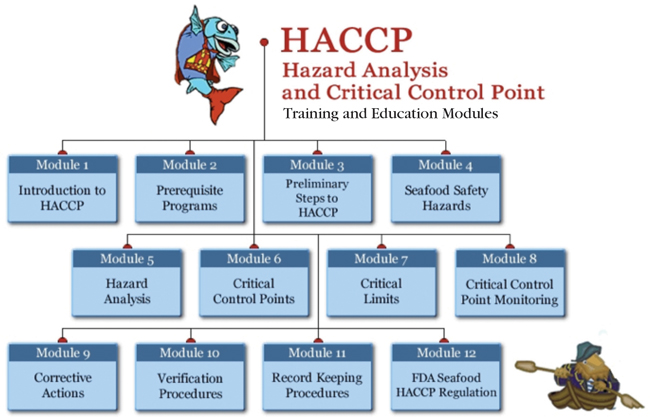
For over a decade, more than 8,100 individuals from seafood companies nationwide and state or federal regulatory agencies participated in food safety training programs conducted or managed by NY Sea Grant. This includes participants of live as well as Internet-based training to meet the requirements of the US Food and Drug Administration’s seafood Hazard Analysis Critical Control Point (HACCP) regulation. Additionally, a secondary course has been offered since 2008 on basic Good Manufacturing Practices.
NYSG is one of four Sea Grant programs in the US that received a $600,000 grant from USDA’s National Integrated Food Safety Initiative to update the national Seafood HACCP Alliance training program. The program, developed in 1995, incorporates new scientific findings and regulatory requirements for a national network of qualified trainers. In 2011, NYSG was a key member of the national team that conducted six workshops in the U.S. to explain the updated FDA Seafood HACCP guidance published in 2011 to 450 individuals from seafood businesses and regulatory agencies.
NYSG also helped requalify 125 trainers who conduct HACCP training in the U.S. and helped conduct a train-the-trainer course in Qingdao,China, for 60 Chinese food safety inspectors who will conduct industry training to ensure that seafood producers that export to the U.S. implement the latest HACCP-based food safety control strategies.
For more on Seafood Safety, see www.nyseagrant.org/seafood.
Sustainable Coastal Development
- Visioning for Lake Ontario Engages Community and Agency Decisionmakers (pdf)
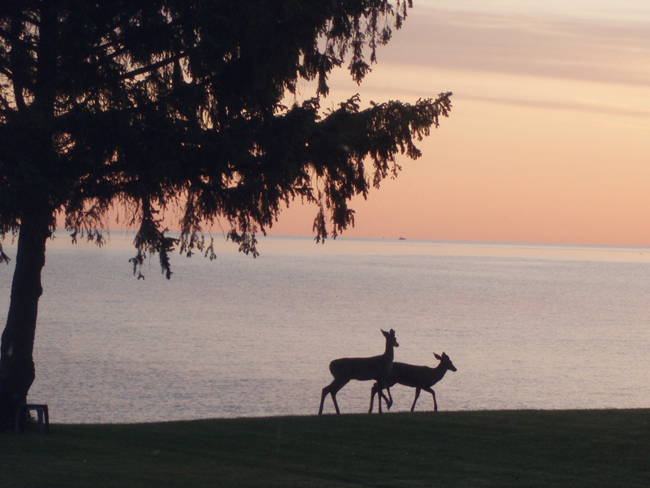
To better align public input on the conservation and restoration needs of the Lake Ontario basin with federal, state and local management plans, New York Sea Grant planned and co-facilitated a public participation and involvement initiative. The result was a half-dozen open communication forums for community and agency decision-makers last fall, during which presentations were made by NYSG, the Finger Lakes–Lake Ontario Watershed Protection Alliance and the New York State Department of Environmental Conservation, among others. Funding for these Lake Ontario visioning workshops was obtained by the Niagara County Soil and Water Conservation District from the U.S. Environmental Protection Agency’s Great Lakes Restoration Initiative Program.
Also, a summary report was recently released that gathers the opinions and input of these stakeholders in regards to the health of the lake and its watershed, priority projects for implementation and additional needs/concerns in these communities. You can now download a PDF of this 67 page report (pdf).
Additional information on NYSG efforts like these can be found via our "Coastal Community Development" resource site, www.nyseagrant.org/ccd.
Photo of Lake Ontario by Helen Domske.
- NYSG Assists Access to New Web-Based Tool: A Boaters’ Forecast for the St. Lawrence River (pdf)
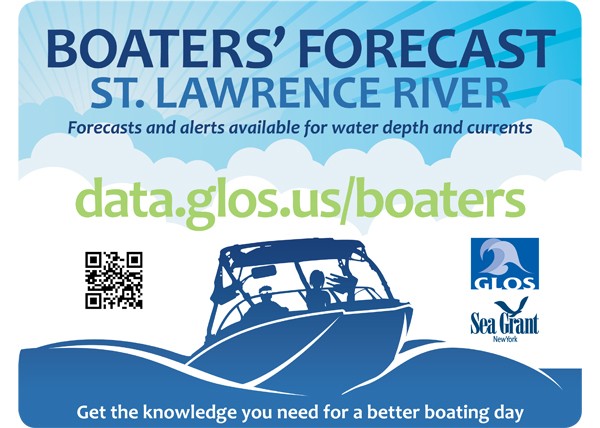
New York Sea Grant (NYSG) helped make a new real-time, Web-based tool
available to recreational boaters on the St. Lawrence River. With information generated from a Great Lakes Observing System (GLOS)
data buoy (pictured here), the new Boaters' Forecast tool for the St.
Lawrence River provides boaters with current and 12-hour-ahead data on
water depth and current.
For more on this story, see NYSG's related news item, "On Air, On YouTube: All Eyes on NYSG-Assisted Web-Based Boaters' Forecast Tool."
And there's more "NYSG Great Lakes Boating & Marine Trades" News available via the "News/Topics" link in the left-hand sidebar at www.nyseagrant.org/marina.
New York Sea Grant is a statewide network of integrated research, education, and extension services promoting coastal economic vitality, environmental sustainability and citizen awareness and understanding about the State’s marine and Great Lakes resources. These three elements, economics, environment, and education, are the foundation of our Strategic Plan and cross-cut all of our goals within four focus areas important to the citizens of New York. Through your continued support, Sea Grant has realized these goals in 2012.
More Info:
New York Sea Grant (NYSG), a cooperative program of Cornell University
and the State University of New York, is one of 33 university-based
programs under the National Sea Grant College Program (NSGCP) of the
National Oceanic and Atmospheric Administration (NOAA). The NSGCP
engages this network of the nation’s top universities in conducting
scientific research, education, training and extension projects designed
to foster science-based decisions about the use and conservation of our
aquatic resources. Through its statewide network of integrated
services, NYSG has been promoting coastal vitality, environmental
sustainability, and citizen awareness about the State’s marine and Great
Lakes resources since 1971.
For updates on Sea Grant activities:
www.nyseagrant.org has RSS,
Facebook,
Twitter, and
YouTube links. NYSG also offers a free e-list sign up via
www.nyseagrant.org/coastlines for NY Coastlines, its flagship publication, and Currents, its e-newsletter supplement, each distributed 3-4 times a year.